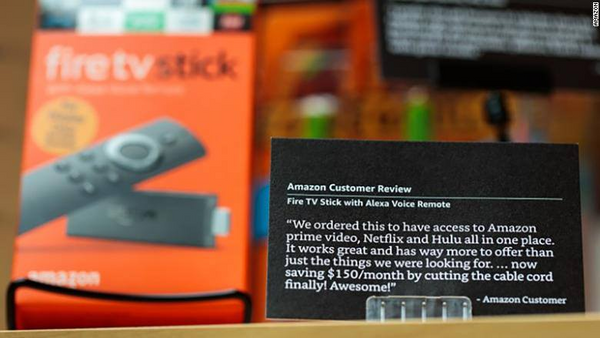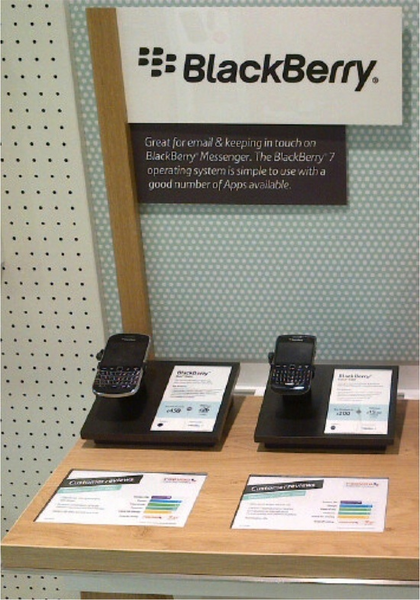When you hear someone mention “customer reviews,” you probably think about the comments and product ratings on ecommerce websites and online stores. But enterprising retail brands increasingly are looking for ways to bring this valuable, user-generated content off the web and into their brick-and-mortar stores.
For example, bookstores have long curated “staff picks” sections as a way to highlight popular products. Many retailers are taking this idea a step further, incorporating customer ratings into their sales pitch in fresh, innovative ways.

Take Amazon 4-star stores: an ecommerce retailer of Amazon’s size obviously can’t open a store showcasing even a modest fraction of the products it offers online. To narrow the selection, Amazon takes the best-loved products, based on actual customer reviews and ratings, from its digital realm and offers them in store.
Below, we’ll look at why using customer reviews in-store is beneficial for retailers, who are finding new ways to do it, and how you can leverage ratings and reviews in your own brick-and-mortar store.
Why you should bring customer reviews in-store
In a recent survey by Podium, 93% of respondents said online reviews influence their purchasing decisions. Another survey from Power Reviews found that 70% of shoppers want to see product ratings and reviews while they shop in-store.
Bringing customer reviews in-store, at minimum, eliminates a step for shoppers.
Easily accessible reviews make it easier for customers to both find the information they want and make purchasing decisions.
Plus, when you bring reviews into your store, you take one more step toward melding the convenience of online shopping with the experience of shopping in-store, combining the best of both worlds instead of forcing one to compete against the other.
FURTHER READING: Learn more about how creating a cohesive multichannel experience can help your retail business prosper.
The days of one-sided push marketing are over, and physical stores need to reflect that shift and find innovative ways to give customers what they’re looking for. As Mark Lange, the chief marketing officer of Reputation.com, recently wrote: “You’re co-creating your brand with customers through review sites and social networking.”
Innovative ways retailers are using customer reviews in store
The case for using customer reviews in your brick-and-mortar location is clear—that’s why retailers are searching for new ways to bring more online reviews and product ratings into their stores.
A few retailers have landed on some truly innovative uses for in-store customer reviews and ratings. Here’s a look at a few.
FURTHER READING: Customer reviews don’t just help encourage purchases—they can also help with local SEO. Learn how ratings can impact your local search rankings and affect your bottom line.
Amazon 4-star

As mentioned above, Amazon 4-star stores use online customer reviews to inform which products they stock. Every item you see in a physical Amazon shop has a minimum customer rating of four stars and carries a “digital price tag” displaying the average rating and the number of reviews that informed that rating. This can help assure customers of both the quality and popularity of the item.
Rent the Runway

If you’ve been paying attention to the retail industry over the past few years, you may have noticed a trend: many brands that once sold their wares exclusively online are diving into the brick-and-mortar world.
Ecommerce has a very transactional nature—customers pay for a product and the retailer ships it out. Many online brands, as they grow, are searching for ways to build a stronger relationship with their customers, beyond this simple, impersonal transaction.
Rent the Runway, which rents designer dresses and accessories, knows ecommerce limits the extent to which customers can get to know a product. Its physical retail showrooms solve this problem by enabling customers to try on apparel and accessories before renting them. Their showrooms are also unique in that RTR exclusively stocks well-rated and -reviewed items, giving customers an added level of comfort.
Marcopolo
Marcopolo takes a different approach to bringing digital content into its physical stores. The Italian retailer built an app dedicated to in-store use and designed to combat customer showrooming (visiting a store to look at a product, only to then order it elsewhere online at a lower price).
TRY SHOPIFY POS: Use Shopify POS email carts to recover abandoned store sales and turn more browsers into buyers.
Marcopolo’s app shows customers a product’s reviews and other information by scanning QR codes throughout its store. This puts the retailer back in the driver’s seat and helps it convert in-store purchases by encouraging the customer’s existing tendencies to use their smartphones for conducting product research while in-store. Customers are less likely to wind up on a competitor’s website if they can find what they’re looking for quickly.
Tesco

Tesco, a popular British retailer and grocery store chain, takes an approach similar to Amazon’s in its mobile department, displaying customer reviews alongside its devices. Curating the reviews gives Tesco an extra level of control over the user-generated content customers see and saves customers the step of having to search for reviews. (It also creates a level playing field for those customers without a smartphone who still walk among us.)
Tips for bringing your customer reviews in-store
Now that you’ve seen how retailers are bringing customer reviews into the brick-and-mortar stores, let’s look at how you can do the same.
Above all, don’t be afraid to get creative. Customers are looking for social proof, so any way you can bring that proof into your physical store is worth testing.
Below are a few more tips to help you leverage online ratings and reviews.
Cultivate a robust portfolio of customer reviews online
You have to have customer reviews before you can bring them into the physical retail world. Encouraging customers to leave the right kind of review—ones that help others gather the information they actually want to make a decision—is key.
FURTHER READING: Learn how to encourage your customers to leave product ratings and reviews online.
Curate store inventory based on customer ratings and popularity
If your brand exists in both the ecommerce and brick-and-mortar realms (or if you’re planning to expand into physical retail), customer reviews can be an invaluable signal to help you decide which products to stock in your physical store. Leaning on customer ratings makes it easier to find the products that will yield the best returns in-store, and stocking only products with a certain minimum rating helps customers develop a baseline level of trust in the products they find in your store.
Make customer reviews accessible to your audience
Take a page out of Tesco’s playbook by stopping to consider your audience before you decide how best to leverage customer reviews in store.
Are your customers young tech natives? If so, a QR code that can be scanned with their smartphone will probably work well. If you’re serving a less tech-savvy crowd, you might be better off including customer reviews on in-store displays or even digital signage.
Choose the right reviews to showcase
Just like in the digital world, there’s a fine line between curating the reviews you show to customers and censoring them. The difference can often come down to your intent—is your ultimate goal to inform customers, helping them make the best decision for them?
Also, take the time to consider the usefulness of the reviews you showcase in store. A review that says “Great product!” doesn’t tell customers very much. Look for more in-depth reviews that speak to the features that matter to your shoppers.
Bring online customer reviews into your store
Back in early 2018, we asked several retail experts for their best advice on marketing and growing a retail store. Jason Goldberg, founder of RetailGeek and GVP of commerce strategy at Razorfish, said, “Today's shopper is way savvier than ever before. To cater to these empowered shoppers and to facilitate unplanned purchases, it's critical that retail environments provide access to rich product information and especially provide social proof for in-store purchases.”
Listen to Jason—let your online customer reviews do double the work by using them in store.
For more details on customer reviews and product ratings, read some of these related articles:





